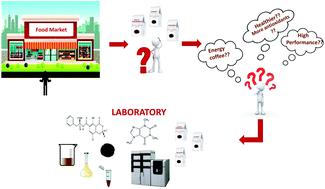当前位置:
X-MOL 学术
›
Food Funct.
›
论文详情
Our official English website, www.x-mol.net, welcomes your feedback! (Note: you will need to create a separate account there.)
Contents of key bioactive and detrimental compounds in health performance coffees compared to conventional types of coffees sold in the United States market.
Food & Function ( IF 6.1 ) Pub Date : 2020-07-22 , DOI: 10.1039/d0fo01674h Juliana dePaula 1 , Sara C Cunha 2 , Ildi Revi 3 , Alessandro M Batista 1 , Soraia V M D Sá 2 , Veronica Calado 4 , José O Fernandes 2 , Adriano Cruz 5 , Adriana Farah 1
Food & Function ( IF 6.1 ) Pub Date : 2020-07-22 , DOI: 10.1039/d0fo01674h Juliana dePaula 1 , Sara C Cunha 2 , Ildi Revi 3 , Alessandro M Batista 1 , Soraia V M D Sá 2 , Veronica Calado 4 , José O Fernandes 2 , Adriano Cruz 5 , Adriana Farah 1
Affiliation

|
The United States is the largest coffee consuming country worldwide. Recently, in addition to cup quality, the focus on health promotion has increased significantly in the country, with launching of many brands with health claims, mainly highlighting the antioxidative and stimulating properties of the beverage. On the other hand, mycotoxins and, to a lesser extent, acrylamide, have raised concerns among consumers and health authorities. This study investigated the contents of the main bioactive compounds (caffeine, chlorogenic acids and their 1,5-γ-quinolactones, and trigonelline) in health performance coffees and compared them to those of conventional roasted coffees available on the U.S. market. The following categories were compared by ANOVA at p ≤ 0.05, followed by Fisher's test: 1 – health performance, 2 – gourmet and 3 – traditional, totaling 127 samples. As complementary results, the contents of acrylamide and ochratoxin A were evaluated in part of the samples (n = 58). The mean contents (g per 100 g) of bioactive compounds for categories 1 to 3, respectively, were 1.09, 1.11 and 1.07 for caffeine; 1.75, 1.88 and 1.34 for chlorogenic acids/lactones, and 0.63, 0.64 and 0.56 for trigonelline. The mean contents (μg kg−1) of acrylamide for categories 1 to 3, respectively, were 82, 71 and 85. Only about 7% of the evaluated samples presented quantifiable amounts of OTA and all of them were within the maximum limits established by health authorities. In general, the contents of bioactive and potentially harmful compounds were not consistently different among categories, with high and low individual amounts in all of them. Most health claims on labels related to the amount of bioactive compounds in health performance coffees were unjustified, suggesting the need for improvement in coffee labeling regulation in the U.S.
中文翻译:

与在美国市场上销售的传统类型咖啡相比,健康性能咖啡中关键生物活性和有害化合物的含量。
美国是全球最大的咖啡消费国。最近,除了杯子的质量外,该国对健康促进的关注也大大增加,许多具有健康声称的品牌的推出,主要突出了饮料的抗氧化和刺激特性。另一方面,霉菌毒素和较小程度的丙烯酰胺引起了消费者和卫生当局的关注。这项研究调查了具有健康功效的咖啡中主要生物活性化合物(咖啡因,绿原酸及其1,5-γ-喹内酯和trigonelline)的含量,并将其与美国市场上的常规烘焙咖啡进行了比较。ANOVA在p处比较了以下类别≤0.05,然后进行Fisher检验:1 –健康表现,2 –美食,3 –传统,共127个样本。作为补充结果,评估了部分样品中丙烯酰胺和曲霉毒素A的含量(n = 58)。第1到第3类的生物活性化合物的平均含量(每100克g)分别为咖啡因1.09、1.11和1.07;绿原酸/内酯的浓度为1.75、1.88和1.34,而三氯萘林的浓度为0.63、0.64和0.56。平均含量(μgkg -11至3类的丙烯酰胺分别为82、71和85。仅约7%的被评估样品具有可量化的OTA量,且所有样品均在卫生当局规定的最大限量之内。一般而言,生物活性和潜在有害化合物的含量在类别之间并没有一致的差异,所有类别中的个体含量都很高或很低。关于与健康咖啡中生物活性化合物含量有关的标签上的大多数健康声明都是不合理的,这表明美国需要改进咖啡标签法规。
更新日期:2020-09-23
中文翻译:

与在美国市场上销售的传统类型咖啡相比,健康性能咖啡中关键生物活性和有害化合物的含量。
美国是全球最大的咖啡消费国。最近,除了杯子的质量外,该国对健康促进的关注也大大增加,许多具有健康声称的品牌的推出,主要突出了饮料的抗氧化和刺激特性。另一方面,霉菌毒素和较小程度的丙烯酰胺引起了消费者和卫生当局的关注。这项研究调查了具有健康功效的咖啡中主要生物活性化合物(咖啡因,绿原酸及其1,5-γ-喹内酯和trigonelline)的含量,并将其与美国市场上的常规烘焙咖啡进行了比较。ANOVA在p处比较了以下类别≤0.05,然后进行Fisher检验:1 –健康表现,2 –美食,3 –传统,共127个样本。作为补充结果,评估了部分样品中丙烯酰胺和曲霉毒素A的含量(n = 58)。第1到第3类的生物活性化合物的平均含量(每100克g)分别为咖啡因1.09、1.11和1.07;绿原酸/内酯的浓度为1.75、1.88和1.34,而三氯萘林的浓度为0.63、0.64和0.56。平均含量(μgkg -11至3类的丙烯酰胺分别为82、71和85。仅约7%的被评估样品具有可量化的OTA量,且所有样品均在卫生当局规定的最大限量之内。一般而言,生物活性和潜在有害化合物的含量在类别之间并没有一致的差异,所有类别中的个体含量都很高或很低。关于与健康咖啡中生物活性化合物含量有关的标签上的大多数健康声明都是不合理的,这表明美国需要改进咖啡标签法规。


























 京公网安备 11010802027423号
京公网安备 11010802027423号